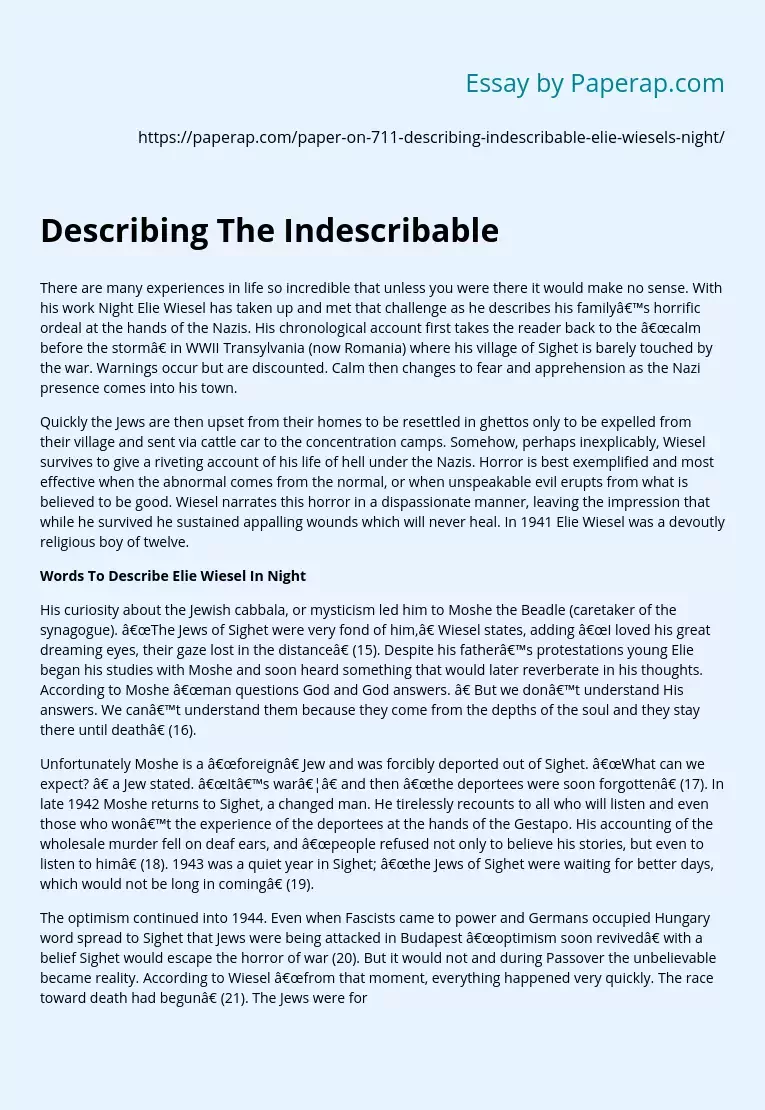Describing The Indescribable
There are many experiences in life so incredible that unless you were there it would make no sense. With his work Night Elie Wiesel has taken up and met that challenge as he describes his family’s horrific ordeal at the hands of the Nazis. His chronological account first takes the reader back to the “calm before the storm” in WWII Transylvania (now Romania) where his village of Sighet is barely touched by the war. Warnings occur but are discounted. Calm then changes to fear and apprehension as the Nazi presence comes into his town.
Quickly the Jews are then upset from their homes to be resettled in ghettos only to be expelled from their village and sent via cattle car to the concentration camps. Somehow, perhaps inexplicably, Wiesel survives to give a riveting account of his life of hell under the Nazis. Horror is best exemplified and most effective when the abnormal comes from the normal, or when unspeakable evil erupts from what is believed to be good.
Wiesel narrates this horror in a dispassionate manner, leaving the impression that while he survived he sustained appalling wounds which will never heal. In 1941 Elie Wiesel was a devoutly religious boy of twelve.
Words To Describe Elie Wiesel In Night
His curiosity about the Jewish cabbala, or mysticism led him to Moshe the Beadle (caretaker of the synagogue). “The Jews of Sighet were very fond of him,” Wiesel states, adding “I loved his great dreaming eyes, their gaze lost in the distance” (15).
Despite his father’s protestations young Elie began his studies with Moshe and soon heard something that would later reverberate in his thoughts. According to Moshe “man questions God and God answers. ” But we don’t understand His answers. We can’t understand them because they come from the depths of the soul and they stay there until death” (16).
Unfortunately Moshe is a “foreign” Jew and was forcibly deported out of Sighet. “What can we expect? ” a Jew stated. “It’s war…” and then “the deportees were soon forgotten” (17). In late 1942 Moshe returns to Sighet, a changed man. He tirelessly recounts to all who will listen and even those who won’t the experience of the deportees at the hands of the Gestapo. His accounting of the wholesale murder fell on deaf ears, and “people refused not only to believe his stories, but even to listen to him” (18). 1943 was a quiet year in Sighet; “the Jews of Sighet were waiting for better days, which would not be long in coming” (19).
The optimism continued into 1944. Even when Fascists came to power and Germans occupied Hungary word spread to Sighet that Jews were being attacked in Budapest “optimism soon revived” with a belief Sighet would escape the horror of war (20). But it would not and during Passover the unbelievable became reality. According to Wiesel “from that moment, everything happened very quickly. The race toward death had begun” (21). The Jews were forcibly segregated into two separate ghettos and then into one, losing homes and personal property in the process.
Fear gripped the community and soon rumors of deportation became reality. The Jews of Sighet were loaded into cattle cars with the warning any attempt to escape would result in death. Wiesel recounts the inhuman conditions inside the cars. To make matters worse a woman became hysterical, screaming of fires. When they finally came into a camp, and saw the flames from the crematoria, the old woman “had become dumb, indifferent, absent, and had gone back to her corner” (38). Wiesel and his father, separated from the women of the family, were now in Auschwitz.
Describing The Indescribable. (2019, Dec 05). Retrieved from https://paperap.com/paper-on-711-describing-indescribable-elie-wiesels-night/

